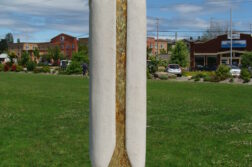Earlier Drag Portrait Is Claimed
To the Editor:
I’d like to respond to the entry in the “BTW” column of the July-August issue regarding the portrait of the Chevalier D’Eon. The art dealer who claims it to be the earliest known portrait of a transvestite is incorrect. This distinction more probably belongs to the portrait of Lord Cornbury now in the collection of the New-York Historical
Society.
Lord Cornbury, a cousin of Queen Anne, was appointed the first royal governor of New York and New Jersey in 1702. He frequently appeared in elaborate female costume, offering the rather specious explanation that in order to fully represent his royal cousin, he needed to look like her in every way. As may be imagined, this led to incidents, among which was his arrest on the New York waterfront by a sheriff who was unable to believe the distinctly unconvincing “lady” who was promenading the docks was in fact the royal governor and not a prostitute.
Lord Cornbury was married to an equally “difficult” wife who had a habit of sending her servants around to “accept the gift” of any silver or china that had caught her eye after being a guest in prominent homes. Lord and Lady were packed off back to England in disgrace following a petition to the Privy Council by a body of leading citizens—not because of Lord C’s fashion choices, but because he was involved in a series of land swindles as well as other arbitrary abuses (such as imprisoning Presbyterian ministers, against whom he had a vendetta for whatever reason).
The portrait, by tradition Lord Cornbury’s official portrait, shows him dressed in a formal gown. The provenance of the painting is established as far back as the early 19th century, but the tradition cannot, unfortunately, be authenticated beyond question. Interestingly, Lord Cornbury is the only governor of New Jersey whose portrait does not hang in the State House in Trenton. One does not imagine that this absence is likely to be rectified by our present governor.
A. Tobias Grace, Trenton, NJ
Book on Postwar Paris Deserved Better
To the Editor:
This is in response to Edward Field’s piece on Paris after World War II [July-August issue], specifically his comments on Alice Kaplan’s new book, Dreaming in French. I was saddened that, when Field stopped talking about his own experiences in postwar Paris, he did not do justice to what is a very fine book.
However interesting it is to know what he was reading, in English, while in Paris, for Field to assert that “such was the ‘modern’ canon for Jackie, Susan, and Angela, as well, when they were in Paris” shows that he didn’t read the book very carefully. One of the important points Kaplan brings out is that Bouvier and Davis had both spent years studying French before they did their year in Paris, read it fluently, and had read widely in French literature even before they left the U.S.
I’m no great fan of Ms. Kennedy, but, again, for Field to write that “Jackie’s story is the least interesting of the three” in part because “her closest brush with bohemia was a meeting with the upper-class George Plimpton” shows that he simply ignored all that Kaplan tells us about Bouvier’s intense interest in French literature and culture while she was there, and how it allowed her to blossom intellectually in a way that had not been possible in the upper-class world of her upbringing. When he concludes that section of his article with lines like “a life devoted to power shopping isn’t really compatible with hyper-intelligence” and “Jackie’s French indoctrination mainly led to her redecorating the White House,” Field shows that, for whatever reason, he has chosen to ignore Kaplan’s research to the contrary.
His treatment of the other two women isn’t much better. Yes, her time in Paris was important to Sontag’s becoming comfortable with being a lesbian, though she had started that journey while at Berkeley. But as Kaplan shows, what Paris gave her was an exposure to certain modern French intellectuals that were basically unknown in the U.S. and that she found a way to introduce to American readers. Lots of Americans have gone to Paris and enjoyed a more liberated sex life, especially in the past. We haven’t heard of most of them because a good sex life, no matter how enjoyable, isn’t all that newsworthy, unless it’s written about very well (Henry Miller, etc.), and it happens not to be what Sontag wrote about.
Kaplan’s intelligent and very readable book shows how three young American women found remarkable self-fulfillment, primarily intellectual but in Sontag’s case also sexual, in a Paris that, in the late 1940’s to the early 60s, was so very different from the middle-class America of the time. If you’ve seen the movie Revolutionary Road, you saw how suffocating that era was for a certain part of American society and how appealing Paris looked in comparison. I was deeply moved by what Paris did for these three women intellectually in an era when college coeds, even at Smith, were still expected to take typing and interior decoration. Field trivializes Ms. Kennedy’s Paris experience, and really does nothing to show what it did intellectually for the other two women.
Richard M. Berrong, Cuyahoga Falls, Ohio
Inge’s Gayest Play Was Never a Film
To the Editor:
In his excellent article on William Inge, “Beefcake and Beauty Queens” [May-June 2012], Stephen F. Dansky really hit the nail on the head when he stated that there are numerous examples of homophobic theatrical criticism in the 1960’s. I was living in New York City when Inge’s comedy Where’s Daddy? opened on Broadway and closed after only a few performances because of the severe and unjust panning it got from the critics.
The play relates how a young man, Tom, has married a young woman, Teena, “to do the right thing” after getting her pregnant and wanting the child to be legitimate, even though he and Teena are not really in love and have already decided to put the baby up for adoption as soon as it’s born. Meanwhile, Tom, a struggling actor, wants to stay with his middle-aged male ex-lover Pinky. When Tom was only fifteen, Pinky had picked him up (believing his lie that he was eighteen) and mentored and loved him until Teena became “great with child.” Pinky refuses to let Tom back into his life and wants him to man up to his obligations as a husband and father.
I was bold enough at the time to write Inge a letter proposing that we collaborate on a screenplay, since I sincerely believed that the failed stage production would still make a provocative movie. Inge graciously answered my missive as follows (dated October 10, 1969): “Thank you for your interest in Where’s Daddy?, but I don’t see any point in doing a film treatment unless it is sold. I of course think it would make a great movie but I’m not in a position to do anything about it.”
Ben Edward Akerley, Los Angeles
Toward a New Gay Rights Revolution
To the Editor:
I was pleased to see that the GLR had reviewed Shannon Gilreath’s The End of Straight Supremacy: Realizing Gay Liberation, and I applaud the befitting title of the piece—“Can the Revolution Be Recovered?”—which homes in on the most pertinent question that Gilreath set out to answer. I was all the more pleased upon seeing that the review was written by the esteemed historian Dennis Altman, whose book of forty years ago, Homosexual: Opposition and Liberation, is considered “the definitive account of the ideas that shaped the gay liberation era.” I understand it is being reissued; one hopes it will have a revised preface.
Regrettably, I finished Altman’s review thoroughly disappointed by his evident myopia, which he himself seems frankly to ascribe to his being a “former gay liberationist.” Altman concedes some valid points but then he chides Gilreath for his ignorance of “the realities of gay liberation as a social and political movement of the early 1970’s” (though implying later that Gilreath is aware of those realities). But the fact is that it was not this author’s intent to rehash the history of an era but instead to build upon its goals and imagine what it would take to recover the revolution, per your title, and complete the struggle for full equality.
But my main point is not to bury Altman but instead to praise Gilreath’s book, which is talismanic and excitingly transformative for some of us out here in the hinterlands. I read from morning to night most days, and in thirty years I haven’t come across another book that gripped me by the thorax as this one did.
Joel Michael, York, PA
Correction
 In the July-August 2012 issue, an obituary for Henry Van Dyke included a photograph that was not a picture of the deceased. The unlabeled photo was actually of Bobby Short, an intimate acquaintance of Van Dyke who is referenced in the obituary. Van Dyke is pictured at right.
In the July-August 2012 issue, an obituary for Henry Van Dyke included a photograph that was not a picture of the deceased. The unlabeled photo was actually of Bobby Short, an intimate acquaintance of Van Dyke who is referenced in the obituary. Van Dyke is pictured at right.



